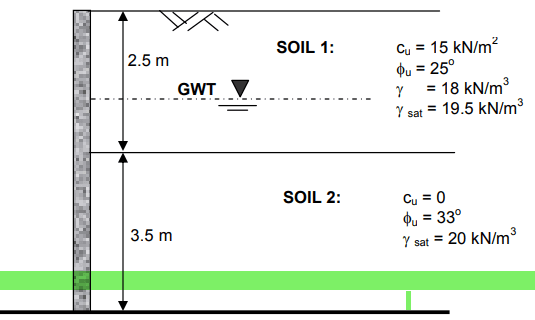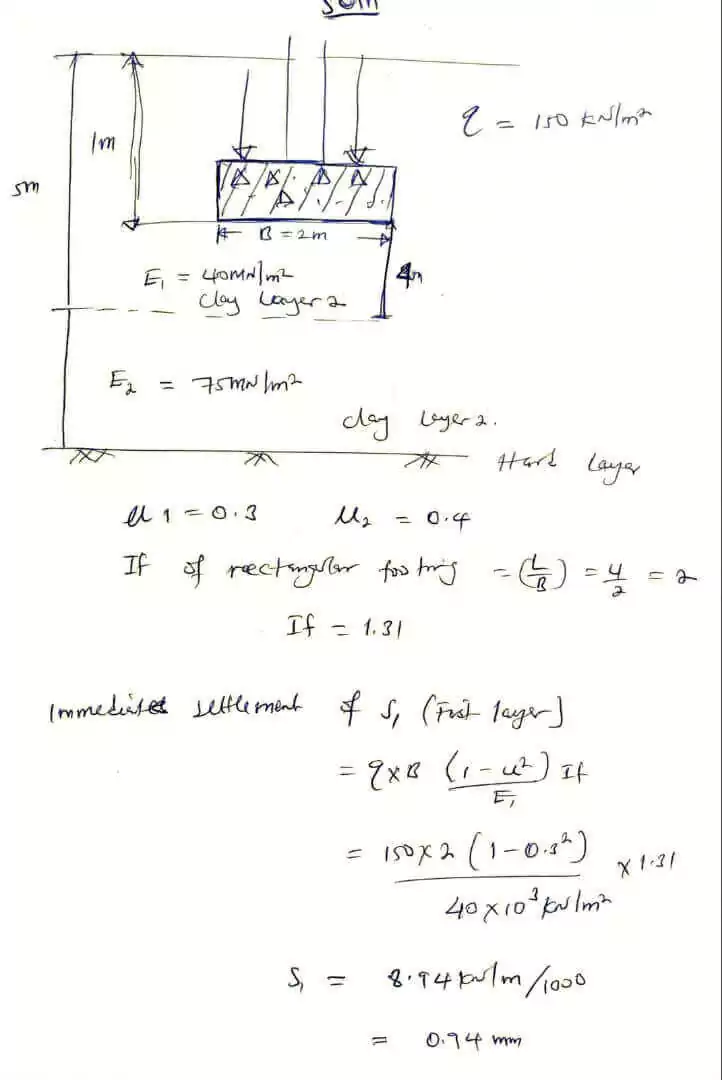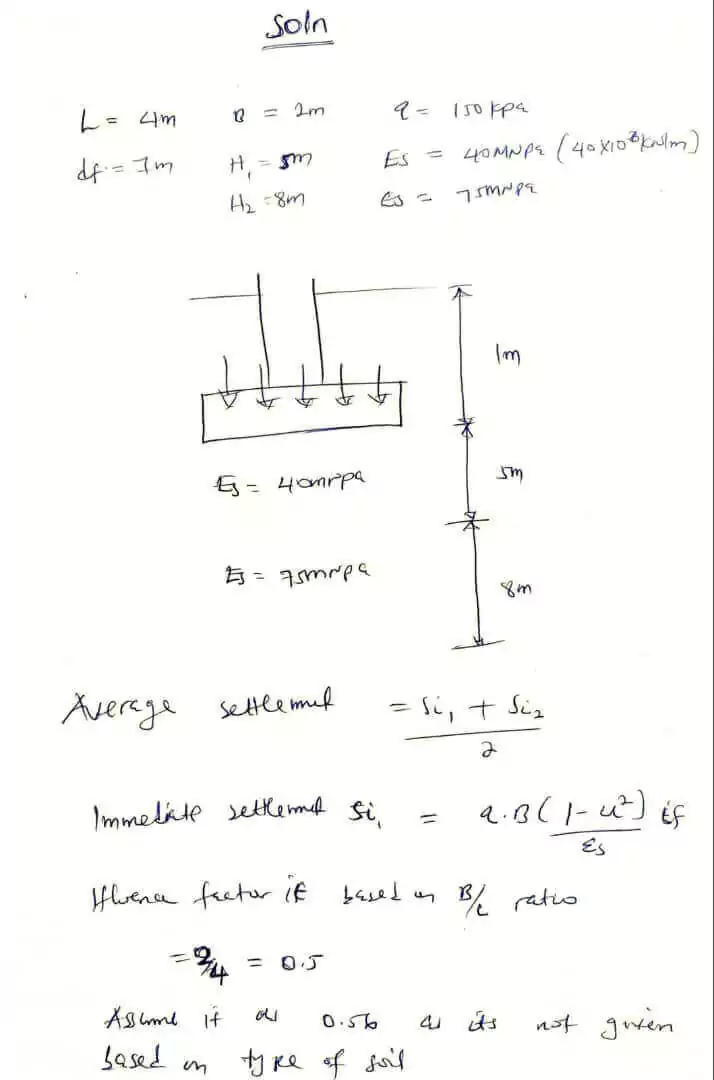SOIL MECHANICS/GEOTECH
Recommend a friend a friend a friend

For the smooth vertical wall shown in Figure Q1, determin…Solved.
Question For the smooth vertical wall shown in Figure Q1, determine the total active thrust on the wall and the position where it acts. Ground water level is at a depth of 1.5 m. Solution

A 10 m high retaining wall has been holding a soil with the…Solved.
Question A 10 m high retaining wall has been holding a soil with the following composition: G=2.65, e= 0.50, w=10%, and Ф=20 degrees. Determine the active thrust on the wall due to soil and water, the active thrust on the wall due to soil only, and the increase in force on the wall if the soil is fully saturated with rain water. Solution

For the smooth vertical wall shown in figure Q3. Determin…Solved.
Question For the smooth vertical wall shown in figure below. Determine the total active thrust on the wall and the position where it acts. ground water level is at a depth of 1.5m Solution

Solved: A six story reinforced concrete framed office building for …
Question 1 – A six story reinforced concrete framed office building for the Education Service Commission will be built on a proposed site at Kyambogo Kampala where the soils are expected to be of average quality and homogeneity. The building will have a 30m x 50m footprints, and is expected to be supported by a spread footing located 1.5m below the ground. The site appears virgin with no disturbance, and the bedrock is estimated to be at 30m below. Propose the required number and depth of bore holes to be drilled during geotechnical investigation. 2- During the geotechnical investigation of the site in Qn(1) above, the geotechnical engineer proposed a standard penetration test (SPT) to be done on some critical boreholes to aid the prediction of the bearing strength of the foundation soil. The field data are as shown in the table below. The ground water table was at 15m below the ground. Answer 1

A foundation 4×2 m2 carrying a uniform pressure of (Solved)
Question A foundation 4×2 m2 carrying a uniform pressure of (q-OzD) = • 150 kN/m2 is located at a depth of 1 m in a layer of clay 5 m thick, for which E = 40 MN/m? (undrained modulus). The layer is underlain by a second clay layer 8 m thick and E, = 75 MN/m?. A hard stratum exist below the second layer. • Determine the average immediate settlement under the foundation. Solution to A foundation 4×2 m2… See Related Problem 4 solved, Effective stresses Problem 2.2 solved, Coefficient of soil permeability Problem 6.8, solved Compaction of soil Problem 3 solved, Water pore pressure Immediate settlement The load causes instant changes in the soil stresses, and reduces soil voids, as soon as the load is applied. What causes soil settlement? Geotechnical settlement is typically the result of loading (from a building or vehicles moving along on a road, for example) exceeding the ground’s bearing capacity. Due to site ground pressures, pore water pressure increases and then dissipates, causing consolidation settlement, where the soil beneath the structure moves vertically and horizontally. Weak and poorly compacted soils are particularly vulnerable. Soil settlement can be caused by other factors too, such as changes in soil moisture content, for example, saturated cohesive soils may soften or drier cohesive soils may shrink. Deep excavations and tunneling, plus the collapse of naturally occurring voids or abandoned mine workings, are also key factors in causing different types of settlement. Settlement occurs immediately after a load is applied or take years, depending on the underlying soil conditions Geotechnical engineers often carry out settlement analysis prior to construction to analyze the ground conditions and recommend foundation solutions for preventing settlement in the future.

A foundation 4m x 2m, carrying a uniform pressure of 150(Solved: )…
Question A foundation 4m x 2m, carrying a uniform pressure of 150kPa, is located at a depth of 1m in a layer of clay 5m thick for which the value of Es is 40MPa. The layer is underlain by a second layer of clay 8m thick for which Es is 75MPa. A hard stratum lies below the second layer. Determine the average immediate settlement under the foundation. Solution See Related Immediate settlement The load causes instant changes in the soil stresses, and reduces soil voids, as soon as the load is applied. What causes soil settlement? Geotechnical settlement is typically the result of loading (from a building or vehicles moving along on a road, for example) exceeding the ground’s bearing capacity. Due to site ground pressures, pore water pressure increases and then dissipates, causing consolidation settlement, where the soil beneath the structure moves vertically and horizontally. Weak and poorly compacted soils are particularly vulnerable. Soil settlement can be caused by other factors too, such as changes in soil moisture content, for example, saturated cohesive soils may soften or drier cohesive soils may shrink. Deep excavations and tunneling, plus the collapse of naturally occurring voids or abandoned mine workings, are also key factors in causing different types of settlement. Settlement occurs immediately after a load is applied or take years, depending on the underlying soil conditions Geotechnical engineers often carry out settlement analysis prior to construction to analyze the ground conditions and recommend foundation solutions for preventing settlement in the future.

A foundation 4m x 42m carries a uniform pressure of 200…Solved:
Question A foundation 4m x 42m carries a uniform pressure of 200kPa at a depth of 1m in a layer of saturated clay 11m deep and underlain by a hard stratum. If undrained elastic modulus, Es for the clay is 45MPa, determine the average value of immediate settlement under the foundation. Solution to A foundation 4m x 42m… see related Immediate settlement The load causes instant changes in the soil stresses, and reduces soil voids, as soon as the load is applied. What causes soil settlement? Geotechnical settlement is typically the result of loading (from a building or vehicles moving along on a road, for example) exceeding the ground’s bearing capacity. Due to site ground pressures, pore water pressure increases and then dissipates, causing consolidation settlement, where the soil beneath the structure moves vertically and horizontally. Weak and poorly compacted soils are particularly vulnerable. Soil settlement can be caused by other factors too, such as changes in soil moisture content, for example, saturated cohesive soils may soften or drier cohesive soils may shrink. Deep excavations and tunneling, plus the collapse of naturally occurring voids or abandoned mine workings, are also key factors in causing different types of settlement. Settlement occurs immediately after a load is applied or take years, depending on the underlying soil conditions Geotechnical engineers often carry out settlement analysis prior to construction to analyze the ground conditions and recommend foundation solutions for preventing settlement in the future.

Solved: A foundation 4m x 2m carries a uniform pressure of 200k…
Question A foundation 4m x 2m carries a uniform pressure of 200kPa at a depth of 1m in a layer of saturated clay with modulus of elasticity of 45MN/m2, V=0.5. Determine the average value of immediate settlement for a) The clay layer with 11m deep and underlain with hard stratum and b) the layer with infinite deep Solution See related

A foundation 4m x 2m carries a uniform pressure of 200k (Solved)
Question A foundation 4m x 2m carries a uniform pressure of 200kPa at a depth of 1m in a layer of saturated clay 11m deep and underlain by a hard stratum. If undrained elastic modulus, Es for the clay is 45MPa, determine the average value of immediate settlement under the foundation. Solution to A foundation 4m… See related Immediate settlement The load causes instant changes in the soil stresses, and reduces soil voids, as soon as the load is applied. What causes soil settlement? Geotechnical settlement is typically the result of loading (from a building or vehicles moving along on a road, for example) exceeding the ground’s bearing capacity. Due to site ground pressures, pore water pressure increases and then dissipates, causing consolidation settlement, where the soil beneath the structure moves vertically and horizontally. Weak and poorly compacted soils are particularly vulnerable. Soil settlement can be caused by other factors too, such as changes in soil moisture content, for example, saturated cohesive soils may soften or drier cohesive soils may shrink. Deep excavations and tunneling, plus the collapse of naturally occurring voids or abandoned mine workings, are also key factors in causing different types of settlement. Settlement occurs immediately after a load is applied or take years, depending on the underlying soil conditions Geotechnical engineers often carry out settlement analysis prior to construction to analyze the ground conditions and recommend foundation solutions for preventing settlement in the future. Solution to A foundation 4m…
